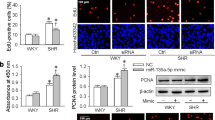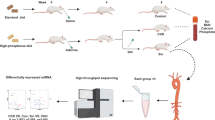Abstract
Contact inhibition and its disruption of vascular smooth muscle cells (VSMCs) are important cellular events in vascular diseases. But the underlying molecular mechanisms are unclear. In this study we investigated the roles of microRNAs (miRNAs) in the contact inhibition and its disruption of VSMCs and the molecular mechanisms involved. Rat VSMCs were seeded at 30% or 90% confluence. MiRNA expression profiles in contact-inhibited confluent VSMCs (90% confluence) and non-contact-inhibited low-density VSMCs (30% confluence) were determined. We found that multiple miRNAs were differentially expressed between the two groups. Among them, miR-145 was significantly increased in contact-inhibited VSMCs. Serum could disrupt the contact inhibition as shown by the elicited proliferation of confluent VSMCs. The contact inhibition disruption accompanied with a down-regulation of miR-145. Serum-induced contact inhibition disruption of VSMCs was blocked by overexpression of miR-145. Moreover, downregulation of miR-145 was sufficient to disrupt the contact inhibition of VSMCs. The downregulation of miR-145 in serum-induced contact inhibition disruption was related to the activation PI3-kinase/Akt pathway, which was blocked by the PI3-kinase inhibitor LY294002. KLF5, a target gene of miR-145, was identified to be involved in miR-145-mediated effect on VSMC contact inhibition disruption, as it could be inhibited by knockdown of KLF5. In summary, our results show that multiple miRNAs are differentially expressed in contact-inhibited VSMCs and in non-contact-inhibited VSMCs. Among them, miR-145 is a critical gene in contact inhibition and its disruption of VSMCs. PI3-kinase/Akt/miR-145/KLF5 is a critical signaling pathway in serum-induced contact inhibition disruption. Targeting of miRNAs related to the contact inhibition of VSMCs may represent a novel therapeutic approach for vascular diseases.
Similar content being viewed by others
Log in or create a free account to read this content
Gain free access to this article, as well as selected content from this journal and more on nature.com
or
References
Hneino M, Bouazza L, Bricca G, Li JY, Langlois D . Density-dependent shift of transforming growth factor-beta-1 from inhibition to stimulation of vascular smoothmuscle cell growth is based on unconventional regulation of proliferation, apoptosis and contact inhibition. J Vasc Res 2009; 46: 85–97.
Hadrava V, Kruppa U, Russo RC, Lacourcière Y, Tremblay J, Hamet P . Vascular smooth muscle cell proliferation and its therapeutic modulation in hypertension. Am Heart J 1991; 122: 1198–203.
Buschmann I, Schaper W . The pathophysiology of the collateral circulation (arteriogenesis). J Pathol 2000; 190: 338–42.
Evans IM, Zachary IC . Protein kinase D in vascular biology and angiogenesis. IUBMB Life 2011; 63: 258–63.
Zhang C . Novel functions for small RNA molecules. Curr Opin Mol Ther 2009; 11: 641–51.
Ji R, Cheng Y, Yue J, Yang J, Liu X, Chen H, et al. MicroRNA expression signature and antisense-mediated depletion reveal an essential role of MicroRNA in vascular neointimal lesion formation. Circ Res 2007; 100: 1579–88.
Cheng Y, Liu X, Yang J, Lin Y, Xu DZ, Lu Q, et al. MicroRNA-145, a novel smooth muscle cell phenotypic marker and modulator, controls vascular neointimal lesion formation. Circ Res 2009; 105: 158–66.
Liu X, Cheng Y, Zhang S, Lin Y, Yang J, Zhang C . A necessary role of miR-221 and miR-222 in vascular smooth muscle cell proliferation and neointimal hyperplasia. Circ Res 2009; 104: 476–87.
Lin Y, Liu X, Cheng Y, Yang J, Huo Y, Zhang C . Involvement of MicroRNAs in hydrogen peroxide-mediated gene regulation and cellular injury response in vascular smooth muscle cells. J Biol Chem 2009; 284: 7903–13.
Liu X, Cheng Y, Yang J, Xu L, Zhang C . Cell-specific effects of miR-221/222 in vessels: molecular mechanism and therapeutic application. J Mol Cell Cardiol 2012; 52: 245–55.
Davis BN, Hilyard AC, Nguyen PH, Lagna G, Hata A . Induction of microRNA-221 by platelet-derived growth factor signaling is critical for modulation ofvascular smooth muscle phenotype. J Biol Chem 2009; 284: 3728–38.
Cordes KR, Sheehy NT, White MP, Berry EC, Morton SU, Muth AN, et al. miR-145 and miR-143 regulate smooth muscle cell fate and plasticity. Nature 2009; 460: 705–10.
Elia L, Quintavalle M, Zhang J, Contu R, Cossu L, Latronico MV, et al. The knockout of miR-143 and -145 alters smooth muscle cell maintenance and vascularhomeostasis in mice: correlates with human disease. Cell Death Differ 2009; 16: 1590–8.
Shantikumar S, Caporali A, Emanueli C . Role of microRNAs in diabetes and its cardiovascular complications. Cardiovasc Res 2012; 93: 583–93.
Solodushko V, Khader HA, Fouty BW . Serum can overcome contact inhibition in confluent human pulmonary artery smooth muscle cells. PLoS One 2013; 8: e71490.
Dong S, Cheng Y, Yang J, Li J, Liu X, Wang X, et al. MicroRNA expression signature and the role of microRNA-21 in the early phase of acute myocardial infarction. J Biol Chem 2009; 284: 29514–25.
Acknowledgements
This work was supported by the National Institutes of Health (No 1R01HL130052) to Chun-xiang ZHANG. This work was also supported by the National Natural Science Foundation of China (No 81670398 and 91639102), the Natural Foundation of Shandong Province (No ZR2013CL003), Qing-dao LING Jun-ren CAI Fund (No #13-CX-3) and the funding of Taishan Scholars of Shandong Province to Binzhou Medical University.
Author information
Authors and Affiliations
Corresponding author
Additional information
Supplementary information is available at the website of Acta Pharmacologica Sinica.
Supplementary information
Supplementary Figure S1
Thirty-five miRNAs that were highly expressed in VSMCs and over 30% difference in their expression signals between low density and high density cells. (JPG 64 kb)
Rights and permissions
About this article
Cite this article
Sun, Yy., Qin, Ss., Cheng, Yh. et al. MicroRNA expression profile and functional analysis reveal their roles in contact inhibition and its disruption switch of rat vascular smooth muscle cells. Acta Pharmacol Sin 39, 885–892 (2018). https://doi.org/10.1038/aps.2018.6
Received:
Accepted:
Published:
Issue date:
DOI: https://doi.org/10.1038/aps.2018.6
Keywords
This article is cited by
-
The role of MicroRNAs in mesenchymal stem cell differentiation into vascular smooth muscle cells
Cell Division (2025)
-
miR-762 modulates thyroxine-induced cardiomyocyte hypertrophy by inhibiting Beclin-1
Endocrine (2019)
-
A new platform for international collaboration on pharmacology and drug development: 2017 China-Canada-USA Pharmacology/Physiology Conference
Acta Pharmacologica Sinica (2018)



